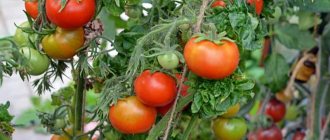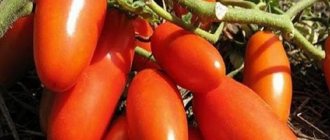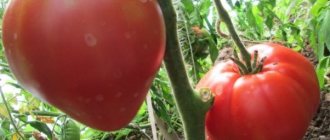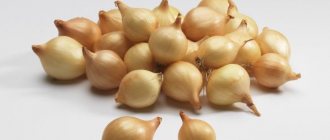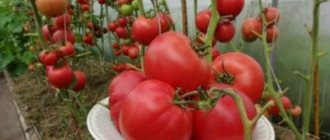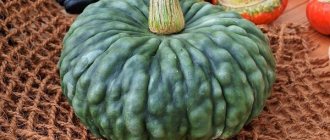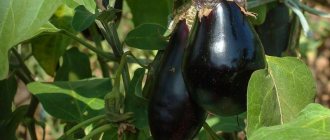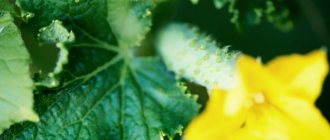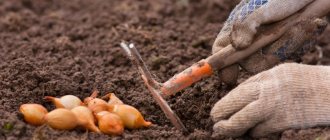Some may think that the "Japanese crab" is a new species of crustacean animal. In fact, this name hides one of the best varieties of tomato. It was bred relatively recently by Siberian breeders. The salad variety has a lot of advantages and quickly fell in love with many farmers. Its seeds are available to everyone, but to successfully grow the crop you need to know some features of agricultural technology. For those who are interested in the variety, we offer to get acquainted with the characteristics and description of the Japanese Crab tomato variety, as well as the features of its cultivation.
Description of vegetables
The Japanese crab tomato can be called the best among many other varieties. It is distinguished, first of all, by its interesting, bright taste and aroma. The variety is ideal for preparing salads, sandwiches and other cold appetizers. Large vegetables are very meaty and contain some free juice. Their average weight is 300 g, but some particularly large fruits reach a weight of 800-900 g. Giants of the “Japanese crab” variety can be seen in the photo below:
Tomatoes of the "Japanese crab" variety are flattened in shape, their surface is ribbed. Inside the tomato there are 5-6 small seed chambers. The color of vegetables changes as they ripen from green to bright red or crimson. You can see a dark spot on the tomato stalk, characteristic of this variety.
Tomatoes have a thick skin that prevents the fruit from cracking. It is able to maintain the integrity of even the largest tomatoes. But despite its strength, the skin of Japanese crab tomatoes is quite tender and homogeneous. It is almost invisible when eating fresh vegetables.
Comments and reviews from the farmer-taster about tomatoes of this variety can be found by watching the video:
The video perfectly demonstrates the external qualities of Japanese Crab tomatoes grown in a greenhouse.
The purpose of tomatoes is universal. They can be used for preparing snacks, various culinary dishes or preserving winter preparations. Large vegetables are difficult to fit into jars, so they should be divided into parts before harvesting. Fleshy tomatoes are excellent for making ketchup or paste. The juice from Japanese crab tomatoes is quite thick.
general characteristics
The tomato variety Japanese crab is of indeterminate type; the bush reaches 1.8-2 m in height, so it needs staking and shaping.
The characteristics of the bush include the following features:
- the stem is massive, thick, green, without pubescence;
- leaves are dense, corrugated, medium in size, elongated with a small cross-section at the edges;
- inflorescences are simple;
- 6-7 flower clusters are formed on one bush, each with 5-6 fruits.
If you follow all the rules of agricultural technology, you can get up to 11 kg of delicious tomatoes from 1 m².
Spreading
The culture is popular throughout our country:
- in the south (in the Krasnodar Territory, Astrakhan Region and Kuban) it is cultivated in open ground;
- in Central (Kursk, Belgorod region), Moscow region, Leningrad region, in the North, the Urals and Siberia, they are cultivated in polycarbonate greenhouses or greenhouses.
Description of fruits
Japanese crab tomatoes are very attractive in appearance and deserve the attention of both experienced and novice gardeners:
- large tomatoes reach 300-400 g in weight;
- the surface is not too thick, so they require careful handling after collection;
- at the stage of full ripening, the fruits acquire a pink tint;
- flat-round shape with lush shoulders and ribbing in the area of the stalk;
- the pulp is multi-chambered, juicy, fleshy, sweet.
The fruits are used in the preparation of salads, ketchup, lecho, juices and cold appetizers. The sweet and aromatic pulp of the fruit is used to make sauces and pastes. Some housewives roll up vegetables in pieces.
Features of the plant
Speaking about the characteristics and description of the Japanese Crab tomato variety, it is worth mentioning not only the quality of the vegetables themselves, but also the bushes that will have to be grown to get a good harvest of tasty fruits. Thus, the bushes of the “Japanese crab” variety are indeterminate and tall. Their height in favorable greenhouse conditions reaches 2 m. To increase productivity, these giants must be correctly and promptly formed into one or two stems. It is worth noting that the proposed variety can be cultivated not only in a greenhouse or greenhouse, but also in an open garden bed. In unprotected conditions, tomatoes must be carefully tied to a reliable support.
Important! “Japanese crab” tomatoes are not a hybrid, which means that tomato seeds can produce full-fledged offspring in future years. You can prepare them yourself.
Indeterminate bushes form fruiting clusters throughout the growing season. The first inflorescence appears, as a rule, above the 7-8 leaf of the plant. Each brush contains about 6-10 simple flowers. To obtain larger fruits, experienced gardeners pinch the clusters, leaving only 4-5 flowers.
The plant forms numerous stepsons that need to be removed in accordance with the selected tomato formation pattern. It is also recommended to pinch the main shoot about a month before the end of fruiting. This measure will speed up the ripening process of existing fruits.
The tomato leaves of the proposed variety are medium sized, light green in color. It is customary to remove the lower leaves of indeterminate tomatoes so that the plant can properly distribute nutrients.
Measures for removing shoots and leaves for all indeterminate tomatoes are similar and must be carried out according to certain rules, which can be learned in detail from the video:
Farmer reviews
Summer residents note that plants produce high yields when the required temperature conditions are observed. Read below to see what else farmers encountered when growing “crustacean” tomatoes.
Ekaterina Ivanova, Moscow region: “For several years I have been breeding Japanese crab tomato varieties. Tomatoes are very tasty, I use them not only fresh, but also in making juices, sauces and other pickles. I don’t experience any particular difficulties in caring for them, the bushes are tall, reaching 150-160 cm, I form them into 2 trunks, and periodically add branches. The tomatoes are large and store well.”
Tatyana Nechaeva, Perm Territory: “For several years I grew this tomato without shelter in a risky farming zone in the north of the Perm Territory, but did not experience any problems. The exception is the cold summer of 2014. During periods of low temperatures (up to +2 degrees), the fruit set poorly. In the greenhouse, the harvest was excellent, only late due to lack of light and heat. I would also like to note the good quality of the seeds: germination is excellent, no mis-grading was observed.”
Alexander Kharlashin, Perm: “I’ve never planted pink tomatoes before. Somehow the family doesn’t particularly like them. But last year, the store persuaded me to buy the Japanese crab variety. It surprised me with its fertility, and my family received even greater surprise and delight from the taste. Now this tomato occupies the most honorable place in the greenhouse. My recommendations!"
Irina Gorko, Tomsk: “Advantages: productive, little late blight, tasty. Disadvantages: Some fruits had an area of dense white-green fiber in the stalk area. They taste juicy and meaty! There is one nuance due to which, in my opinion, my tomatoes were deficient (except for watering with ice water): they were deprived of morning (eastern) sun throughout the first half of the day. The variety, in my opinion, is very productive. I didn’t keep track of the keeping quality, since everything was eaten; I had a ripe red tomato in the refrigerator or in a cool underground for about a week.”
Fruit ripening period and variety yield
Siberian breeders, when creating Japanese crab tomatoes, first of all, took into account the peculiarities of the existing climate in the region. Thus, the proposed tomato variety has a medium-early fruit ripening period. From the day of sowing the seed to the day of harvesting, about 110-115 days should pass. This duration of ripening allows you to grow tomatoes not only in seedlings, but also without seedlings.
The first tomatoes of the proposed variety ripen within 2.5-3 months after sowing the seeds. They are characterized by a particularly large size and can weigh 500-600 g. The yield of the variety as a whole is quite high: with good care, it is possible to collect more than 5 kg of vegetables from each bush. The yield from 1 m2 of land exceeds 15 kg. The process of fruiting of the variety is limited, as a rule, by climatic conditions. In a greenhouse, indeterminate tomatoes can produce a harvest until November.
Important! Tomatoes can be harvested in a heated greenhouse all year round.
Characteristics of Japanese crab tomato
During the ripening period of tomatoes, the plant looks impressive: bright, corrugated fruits sparkle among the dense foliage like Chinese lanterns (see photo).
The first inflorescences are formed above the 7-8 leaf; the brush contains 7-10 flowers. To obtain large tomatoes, it is recommended to leave 4-5 ovaries and remove the rest. The plant has unlimited growth potential and can bear fruit until cold weather.
At the beginning of the growing season, tomatoes with good care reach 600-800 g, the tomatoes on the upper clusters become significantly smaller.
The fruits are red-crimson in color, with pronounced ribbing. The delicate but durable skin prevents the fruit from cracking. Each tomato contains 6-7 seed chambers. The pulp has no white streaks, is sweet with slight sourness and a pronounced aroma. Japanese crab tomatoes tolerate long-distance transportation well.
Resistance to external factors
Often, gardeners, growing tomatoes in a greenhouse or in an unprotected garden bed, are faced with various diseases and pests that can significantly spoil the crop or completely destroy it. The variety “Japanese crab” is genetically resistant to many diseases. So, it is not afraid of crown and root rot, tobacco mosaic. Tomatoes do not have high immune protection against other diseases, so it is worth remembering:
- Prolonged rains and sudden cold snaps can trigger the development of late blight.
- Conditions with high temperature and high air humidity, which are typical for a greenhouse, can become a prerequisite for the development of cladosporiosis.
The development of late blight and cladosporiosis can be prevented by preventive measures. For example, treating plants with ash or trichopolum once every 3 days will not allow fungi and viruses to spread. If foci of the disease are detected, it is recommended to use special drugs. So, you can fight late blight with fungicides. Preparations containing copper can resist cladosporiosis.
The variety does not have genetic resistance against insects. They must be fought with folk remedies in the form of an infusion or decoction, as well as by setting traps.
Diseases and pests
Japanese crab is genetically resistant to crown and brown rot and viral diseases. With sudden changes in temperature and the presence of morning condensation on the leaves of the crop, favorable conditions are created for the bush to be affected by cladosporiosis. Rainy summers with cold nights lead to early outbreaks of late blight epidemics.
Taking into account the extended fruiting of the cultivar, preventive measures are being taken to extend the growing season. Before planting, the soil in the greenhouse is disinfected with the preparation “Baikal” or “Fitosporin”. Seeds are pickled in a solution of potassium permanganate or hydrogen peroxide.
At the beginning of the growing season, the bushes are sprayed with a 1% solution of Bordeaux mixture or other copper-containing fungicide.
On hot days, aphids often appear on tomatoes. At the beginning of summer, you can spray the plant with an insecticide. During the fruiting period, folk remedies with a soap base are used.
Thrips and whitefly are more dangerous for tomatoes grown in a greenhouse. Effective pest control products: “Confidor”, “Aktara”.
The biological insecticide Fitoverm has low toxicity. The period of complete disintegration is three days; it remains in the stomachs of insects for 7-20 days. The drug is effective at air temperatures above +18˚С.
Features of cultivation
“Japanese crab” is a very grateful variety, which only with proper care can produce a good harvest of vegetables. The variety requires special care and attention from the first days of cultivation. So, before you start cultivating tomatoes, it is important to determine the time and place of planting the seeds:
- tomato seeds can be sown in a heated greenhouse in early April;
- in an unheated greenhouse, favorable conditions are established by the beginning of May;
- It is recommended to sow grains in open ground at the end of May - beginning of June;
- At home, tomato seeds are usually sown for seedlings in early April.
It is worth noting that tomato seeds are not afraid of cold and can be sown in open ground quite early, but this will not speed up the process of fruit ripening, since germination of grains will occur only after favorable weather has established. When growing seedlings at home, it is also necessary to pay special attention to the date of planting the seeds, because in favorable conditions the plants can grow quite quickly and exceed the recommended parameters by the time they are planted in the ground.
For different regions of the country, the timing of sowing seeds for seedlings may vary. It is recommended to sow grains for seedlings 60 days before the day the seedlings are supposed to be planted in the ground. At the time of planting, tomatoes should have 6 true leaves and a stem height of about 20-25 cm.
Important! You need to plant tomato seedlings from a common container into separate cups after two true leaves appear.
Seedlings should be placed in open ground or a greenhouse in a two-row or checkerboard pattern. There should be no more than 3 indeterminate plants per 1 m2 of soil. Caring for Japanese crab tomatoes is standard and includes watering, loosening and weeding the soil. Fertilizers must be applied regularly, at least 4-5 times during the entire growing season. It is worth remembering that nitrates can accumulate in ripe fruits, so at the stage of active ripening of tomatoes you need to be more careful with fertilizing.
Planting seedlings
Often purchased seed material of a given variety has already been selected, all seedlings are of high quality. There is no need to carry out the soaking and disinfection procedure. However, in order to awaken the seeds, it is necessary to treat them with a composition that stimulates growth.
One of the best biostimulants is the juice of the aloe plant. By keeping the seed in the plant juice, you can improve the quality of the grains and speed up germination.
However, for this processing it is necessary to prepare properly:
- cut off healthy leaves from aloe that grow below;
- put them in a dark cloth in the refrigerator;
- keep the plant in the cold for at least 10 days.
Thus, aloe will maximize its beneficial properties.
To prepare the composition for soaking seeds you will need:
- break aloe leaves previously kept in the refrigerator into pieces;
- Strain the juice through cheesecloth and squeeze well.
Advice! For soaking, use juice diluted with water in a ratio of 1:2. If the seeds are old, the juice is not diluted.
It is necessary to keep the seeds in this composition for at least 15 hours. To do this, place the grains in a gauze bag and immerse them in aloe juice.
Important! After processing, the grains are not washed, but are immediately sown in the soil
Soil preparation
To plant seeds for seedlings, you need to purchase a special soil mixture. If this is not possible, you can collect land from your summer cottage. In order for the seedlings to grow strong and not be affected by insect pests, it is necessary to steam the soil in the oven. After disinfection, you can begin planting.
Preparing the container
First, a spacious box is taken for planting seedlings. The container must have drainage holes. Over time, after picking, you will need plastic glasses. Seedlings will be planted separately in the new container.
Planting seedlings
By planting seedlings according to the agrotechnical scheme, you can get strong seedlings. It is worth noting that planting takes place in February. The procedure will require snow.
Algorithm for planting Japanese tomato seedlings:
Fill the seedling box with soil mixture. Plant the seeds in pre-moistened soil. Place 2 cm of snow on top of the grains. Melt water will stimulate rapid germination of seed. Cover the box with cling film and set aside in a warm place until the grains germinate. This variety produces early shoots
On day 5, the box is taken out and placed in a well-lit place. Next, it is very important to ensure the correct temperature in the room. The optimal temperature will be 17-20 degrees during the day, and 13-15 at night.
After a week, the sprouts need to be provided with a different temperature regime. The root system of the sprouts will be strong and well developed. To do this, it is necessary to maintain a temperature of 20-24 degrees during the day, and 17-18 degrees at night.
Watering
Watering Japanese tomato seedlings is done as needed. To determine whether young shoots need moisture, you will need to check the top layer of soil. If the soil is dry, it's time to water.
It is very important not to overdo it with hydration. Excess moisture negatively affects sprouts
Seedlings can be affected by a fungal disease, which is very difficult to treat.
Picking
When the first pair of leaves appears on the sprouts, you can start picking. If the seeds were planted in separate containers, the procedure may not be performed. Sprouts planted in a common box dive into separate containers. 700 ml glasses are perfect for this.
Feeding seedlings
In order for the seedlings to grow strong, it is important to fertilize. It will be enough to fertilize the sprouts with mineral fertilizer 3 times.
The interval between feedings should be at least 14 days.
The first feeding is done when the first leaf is formed, the rest - every 2 weeks.
Hardening of seedlings
Hardening is an important and necessary procedure. Such seedlings will be strong and less susceptible to sudden changes in temperature. To do this, it is necessary to accustom the seedlings to cooler temperatures. You can take young tomato sprouts to a cool place, first for 2 hours, then increasing the time to a day. This usually takes about 2 weeks.
Advantages and disadvantages
The variety “Japanese crab” has a lot of advantages:
- amazing taste of fruits and their size;
- high productivity;
- unpretentiousness of the variety, the ability to grow tomatoes in open and protected conditions;
- excellent external qualities of tomatoes;
- universal purpose of vegetables.
In addition to important advantages, the Japanese crab variety also has some disadvantages that should be remembered:
- Poor adaptability of tomatoes for storage.
- Vulnerability of ovaries to unfavorable conditions. Flowers and ovaries may fall off at a temperature of +2-+40C.
Planting and care
Seedling period
In the conditions of the Middle Zone, Altai, southern Siberia and the Urals, Japanese crab tomatoes are sown as seedlings in early March (for unheated greenhouses) or in the middle of this month (for street ridges).
Measures should be taken to prevent excessive stretching of seedlings. If there is a lack of street lighting, it is necessary to organize artificial lighting. Young plants dive after the growth of the first true leaf. An important advantage of the Japanese crab variety is its branched root system, so the volume of soil for each plant should not be too small: preferably from 300 ml to half a liter. It is mandatory to have drainage holes in the planting containers. The soil selected is loose, permeable, with sand. Dampness and excessive watering should be avoided. The seedlings are watered after the top layer of soil has dried.
Disembarkation
Plants are planted in a permanent place before the first cluster blooms. Later dates may cause the first, largest ovary to fall off. There should not be more than three plants per square meter. The surface of the ridges must be mulched.
Fertilizers
For pre-planting soil filling, use humus or compost (5-10 buckets per 10 sq. m), superphosphate and potassium magnesia (a tablespoon per 1 sq. m). After the seedlings take root and begin to grow, the bushes are fed with an aqueous solution of mullein or herbal infusion (1:10). For further weekly fertilizing, humates, wood ash, and complexes of mineral elements are used (boron is especially important). Alternating fertilizing watering and spraying is useful.
Formation
Gartering bushes is a mandatory procedure.
The most massive hands will also need fastening. The most important element of Japanese crab tomato care is regular pinching. The bush is formed strictly into 1 or 2 trunks, promptly removing all the stepsons. For the second stem, leave a stepson under the first brush or directly above it.
As the plants grow, it is necessary to gradually remove the yellowing lower leaves. 4-5 weeks before the end of the season, pinch the tops of the bushes, remove the buds and flower brushes. All nutrition should be aimed at filling those ovaries that are guaranteed to have time to gain full weight.
Results
Thus, we can say with confidence that “Japanese Crab” is an excellent salad variety of tomatoes, with excellent taste characteristics and high external qualities of the fruit. This is confirmed by numerous reviews and descriptions of the variety. Cultivating tomatoes is quite simple if you know some of the features and rules of agricultural technology. We tried to talk about them in detail above in the article, so that every willing farmer has the opportunity to grow a good harvest of tasty tomatoes with his own hands.
Compliance with agricultural technology
Like most large-fruited tomatoes, this variety is preferably grown through seedlings. The optimal time for sowing seeds for seedlings is the first ten days of March.
Seeds of the Japanese crab variety have excellent germination
Preparing the soil for planting seeds for seedlings
A special soil for peppers and tomatoes is perfect for future seedlings. Most often it is a mixture of humus and turf soil in equal parts.
Recent posts 3 ways to make your pear bear fruit faster 2 original flower beds and 1 flower garden from old tires Clematis varieties that bloom very early
It is better to purchase specially prepared soil for growing seedlings.
Immediately before sowing seeds, it is necessary to disinfect the soil using one of the following methods:
- heat the composition in the oven at 200 ºС,
- pour a pink solution of potassium permanganate,
- pour boiling water over it and then dry it.
Preparing seedlings
After sowing the seeds, the soil in the box should be slightly moistened and should not be allowed to dry out. It is recommended to cover the box with the planted seeds with film. Air temperature - 20–25°C. After the seeds germinate, the film should be removed and the temperature lowered to 15–18 ° C (place the box on the windowsill) for 3–4 days for better formation of the root system and for earlier initiation of the flower cluster. Experts advise picking seedlings of this variety after the formation of four true leaves.
Planting seedlings in the ground
Seedlings can be planted in a greenhouse at the age of 45–50 days, in open ground (this option is also possible for this variety) after the threat of frost has passed.
In mid-April, the seedlings will be ready for planting in the greenhouse
Scheme of planting tomato seedlings of indeterminate type
It is recommended to plant tall indeterminate tomato varieties no more often than 2 plants/m2.
Recommended scheme for planting indeterminate tomato seedlings
Immediately after planting the plants in a permanent place, it is necessary to provide stakes for the bushes.
Formation of a bush of the Japanese crab variety
The bush should be formed into one or two stems, regularly carrying out pinching and removing excess foliage. For better ripening of the crop, it is better to pinch the top a month before the end of the season. In a greenhouse this can be done approximately after the seventh brush, and in open ground - after the fifth.
Pinching the top is carried out for better ripening of the fruit harvest.
Watering and fertilizing
Tomatoes of this variety are watered infrequently, like other varieties, but regularly, with settled water directly into the holes or on the surface around the plants, but avoiding water getting on the leaves. This method of watering helps to avoid fungal diseases.
An indeterminate variety of tomatoes will have to be fed at least three times a season.
You can feed tomatoes with complex mineral fertilizer
- The first time feeding is carried out at the beginning of the formation of ovaries on the lower hands;
- second feeding - after three weeks;
- the third - a month before the end of the harvest.
Disease Prevention
The variety is characterized as resistant to root and blossom end rot, as well as tobacco mosaic. As a preventative measure to prevent other diseases, you can spray once every two to three weeks with warm water with the addition of 1 liter of milk and 25 drops of alcoholic iodine tincture per bucket of water. It is especially useful to carry out this procedure during cold nights.
Tomatoes respond well to spraying with water with the addition of milk and a few drops of iodine.
I am not yet familiar with this particular variety from the Siberian collection; I grow other pink-fruited indeterminate varieties. I really appreciate the taste of pink tomatoes. I would like to share a few tips on feeding tomatoes in a greenhouse. A week and a half after planting the seedlings, it is useful for them to fertilize with yeast, which is an excellent growth stimulator. To do this, you need to dissolve 10 g of dry yeast and 25 g of sugar in 8 liters of water. And then dilute it with water in a ratio of 1:10 and water the plants from a watering can. And one more thing: if the weather is predominantly cloudy, the plants need more potassium; in hot weather, the dose of nitrogen should be increased. But under no circumstances should you overfeed tomatoes, otherwise they will become fat and produce more foliage than fruit.
The Japanese crab variety attracts gardening lovers with its unique appearance, excellent taste, and bright aroma.
Almost all reviews about the Japanese crab variety that can be found on the Internet are positive. Here are some of them.
The harmonious sweet taste with pleasant sourness, bright aroma and original appearance of Japanese crab tomatoes will not leave you indifferent. Like everyone who has already encountered him, you will want to have him in your collection.
How to care
Many summer residents who have tried to grow “Japanese crab” express a sharply negative attitude towards the variety. The problem is that the yield of a variety can only be ensured if the agrotechnical conditions required for it are strictly observed.
Watering
Siberian breeders recommend watering the “Japanese crab” once every 1-2 weeks, however, in the dry summer conditions that prevail in more southern regions, this frequency is not enough. Therefore, in this regard, you need to be guided by the condition of the soil: as its top layer dries out, watering is carried out.
For “Japanese crab”, the general rules for watering all tomatoes are relevant, namely:
- You should never water the plant on top of the foliage, especially not in the bright sun;
- for irrigation, you need to use water at the same temperature that is held on the soil;
- The ideal form of irrigation, both from the point of view of preventing waterlogging and from the point of view of rational use of water, is a drip irrigation system (in this case, watering can be turned on even during the day, it is not necessary to wait until sunset).
Feeding
If the soil under the tomatoes is sufficiently fertile and enriched with organic matter, and the seedlings have been grown correctly, to ensure good productivity of “Japanese crab”, it is enough to carry out no more than 2-3 fertilizing treatments throughout the entire growing season. For this purpose, you can use any mineral fertilizers, with only one caveat: after the beginning of the fruiting period, the nitrogen content in the fertilizer should be reduced, otherwise all the forces of the bush will be directed to the formation of green mass, and the tomatoes will be small and sparse.
Important! With a lack of lighting, tomatoes are especially in dire need of potassium fertilizers.
The first feeding is carried out a month after planting the seedlings in open ground, the second - with the beginning of fruiting, and the third, if necessary, another month or a month and a half later.
Stepsoning
“Japanese crab”, grown in open ground, is recommended to be formed into one or two stems (the second stem is grown from a stepson that grows above the first leaf). In regions with colder climates, it is better to focus on leaving a single stem, since a crop formed on two stems at once simply does not have time to ripen until the end of the short and not warm summer. The remaining stepsons (the buds of shoots that form above each leaf up to the first fruit cluster) should be carefully plucked off as they appear.
To obtain a higher yield and protect the bush from the development of fungal diseases, it is also very important to remove dried twigs and leaves in a timely manner.
Soil care
Weeding and loosening the soil after each watering to avoid the appearance of cracks in it, through which moisture that gets into the ground actively evaporates, are standard procedures for traditionally growing tomatoes in the garden.
Modern technologies can significantly simplify the gardener’s work, while ensuring much higher crop productivity. Thus, a conventional drip irrigation system (it is not at all difficult to install; all the necessary equipment is commercially available and inexpensive) allows you to solve the issue of loosening: with this method of watering, the soil around the bush does not crack. If you mulch the beds with hay, peat or pine needles, you can not only retain moisture in the soil for a long time, but also get rid of weeds.
Video: Advantages and disadvantages of replanting under agrofibre
Another way to combat weeds is to plant tomatoes on top of black agrofibre: the material is laid on top of the prepared bed, then a cross-shaped cut is made in the fabric at the site where the future bush is planted, the fiber is bent, a hole is dug in the hole formed, and after planting the bush in it, the edges are folded again .
However, no matter what method of soil care is chosen, the rule remains the same: there should be no weeds in the tomato bed, and the soil around the bush should not be hard as a rock after the water poured on it has dried.
Tying up a bush
It is necessary to tie up the “Japanese crab”, otherwise the branches with large fruits will lie on the ground and even if the bush does not break, the tomato will not be able to ripen completely and evenly. Of course, if only 5 bushes are planted in the garden, you can carefully drive a peg near each of them and tie the trunk to this simple support. However, when occupying larger areas, this method of strengthening bushes is unprofitable.
Modern agricultural technology for growing tall tomatoes offers three main methods of garter:
- trellises (stable posts are driven in at the beginning and end of the bed, strong threads are stretched between them in several tiers, and trunks are tied to them);
- cages (individual wire frames that are installed next to each bush and are reusable);
- caps (frames tapering upward from improvised means that cover each bush).
The most rational and simplest method of gartering is the trellis method, however, each owner can choose for himself any of the others listed above.
Preventative treatment
“Japanese crab” is a variety that initially exhibits increased resistance to fungal infections and pests, therefore, when creating favorable conditions for tomatoes, there is no urgent need for preventive treatments of the beds. However, if the summer is rainy and the nights are cool, to prevent the development of late blight, it is recommended to treat the bushes 2-3 times with a three-day break with Fitosporin, Trichopolum or a solution of wood ash. If high humidity is accompanied by too high an air temperature, tomatoes are threatened by cladosporiosis (brown spot).
To prevent this disease, you can use folk remedies (for example, a weak solution of potassium permanganate, the same solution of wood ash, or a special recipe: 25 drops of iodine and a liter of cow's milk per bucket of warm water) or modern drugs. Among these are “Bravo”, “NeoTek” and others. A solution of copper sulfate, colloidal sulfur and polycarbacin (respectively 1 tablespoon, 3 tablespoons and 1 tablespoon per bucket of water) is also used to prevent brown spot.
Among the insect pests that can attack the “Japanese crab” during the season, it is worth remembering first of all:
- Colorado potato beetle;
- stink bug;
- mole cricket;
- whitefly;
- wireworm;
- scoop;
- aphids (cotton or melon);
- nematode;
- thrips;
- nightshade miner;
- spider mite.
Preventive treatments against such a scourge do not make sense, since the use of insecticides harms the quality of the crop. It is better to prevent infection by following the rules of crop rotation and promptly carrying out preventive disinfection of the beds.
When the first signs of parasites appear, you can try treating the bushes with a soap solution or rich infusions of wormwood, yarrow, tobacco, garlic or chamomile. There is an option to use modern biological preparations that act specifically on the pest and are safe for humans. For example, such drugs include “Verticillin”, “Bitoxibacillin”, “Boverin”, “Guapsin”.
How did tomato crabs originate?
Japanese crab tomatoes appeared on our beds only in the 2000s
The Japanese crab variety appeared in our garden beds and greenhouses not very long ago, but has already become quite popular. Barnaul agro specialists managed to develop such an original variety of tomatoes. Convinced of the stability of the varietal characteristics of the new variety of tomato, in November 2005 the enterprise submitted an application to the State Varietal Commission for the plant to undergo variety testing. Already in 2007, the Japanese crab tomato was included in the State Register by the commission for testing and protection of breeding achievements as a variety that can be grown throughout our country .
Harvesting and application
The first fruits will ripen 110-115 days after emergence. Use them fresh: for salads, sandwiches, slicing. Prepare tomato paste, lecho, snacks or sauce. For juice and pickling in whole fruit form, Japanese crab is not the best choice: the juice is thick, large tomatoes do not fit through the neck of the jars.
Tomatoes have poor shelf life, so consume them within 7-10 days after picking them from the bush.
Pick tomatoes when they are fully ripe (the whole fruit is pink), as they may spoil as they ripen. If there are no other options, when using unripe fruits, remove the dense green area near the stalk.
Tomatoes are varietal, not hybrid. Collect seeds to plant next season.
